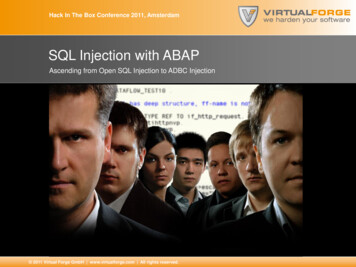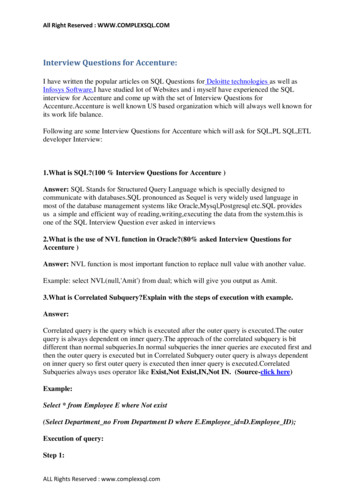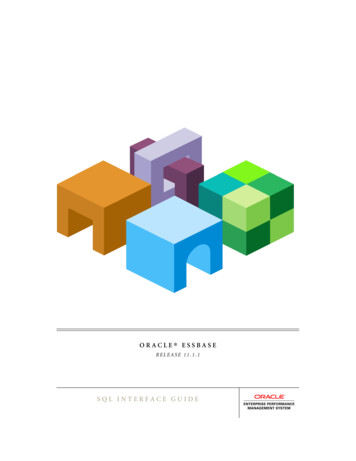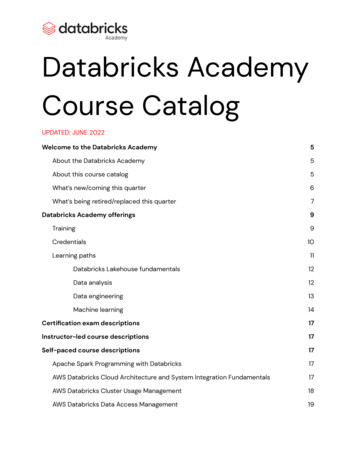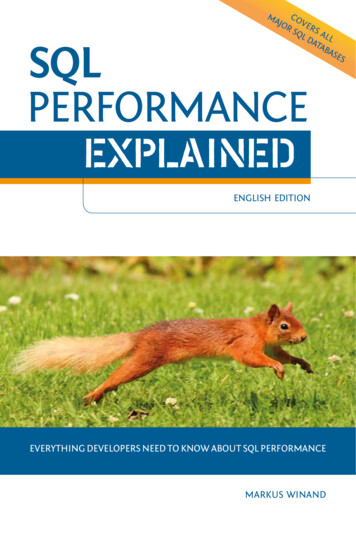
Transcription
MA COJOR VERSQ S AL D LLATABASESSQLPERFORMANCEEXPLAINEDENGLISH EDITIONEVERYTHING DEVELOPERS NEED TO KNOW ABOUT SQL PERFORMANCEMARKUS WINAND
Publisher:Markus WinandMaderspergerstasse 1-3/9/111160 WienAUSTRIA office@winand.at Copyright 2012 Markus WinandAll rights reserved. No part of this publication may be reproduced, stored,or transmitted in any form or by any means —electronic, mechanical,photocopying, recording, or otherwise — without the prior consent of thepublisher.Many of the names used by manufacturers and sellers to distinguish theirproducts are trademarked. Wherever such designations appear in this book,and we were aware of a trademark claim, the names have been printed inall caps or initial caps.While every precaution has been taken in the preparation of this book, thepublisher and author assume no responsibility for errors and omissions, orfor damages resulting from the use of the information contained herein.The book solely reflects the author’s views. The database vendors mentioned have neither supported the work financially nor verified the content.DGS - Druck- u. Graphikservice GmbH — Wien — AustriaCover design:tomasio.design — Mag. Thomas Weninger — Wien — AustriaCover photo:Brian Arnold — Turriff — UKCopy editor:Nathan Ingvalson — Graz — Austria2013-10-03
SQL Performance ExplainedEverything developers need toknow about SQL performanceMarkus WinandVienna, Austria
ContentsPreface . vi1. Anatomy of an Index .The Index Leaf Nodes .The Search Tree (B-Tree) .Slow Indexes, Part I .12462. The Where Clause . 9The Equality Operator . 9Primary Keys . 10Concatenated Indexes . 12Slow Indexes, Part II . 18Functions . 24Case-Insensitive Search Using UPPER or LOWER . 24User-Defined Functions . 29Over-Indexing . 31Parameterized Queries . 32Searching for Ranges . 39Greater, Less and BETWEEN . 39Indexing LIKE Filters . 45Index Merge . 49Partial Indexes . 51NULL in the Oracle Database . 53Indexing NULL . 54NOT NULL Constraints . 56Emulating Partial Indexes . 60Obfuscated Conditions . 62Date Types . 62Numeric Strings . 68Combining Columns . 70Smart Logic . 72Math . 77iv
SQL Performance Explained3. Performance and Scalability .Performance Impacts of Data Volume .Performance Impacts of System Load .Response Time and Throughput .798085874. The Join Operation . 91Nested Loops . 92Hash Join . 101Sort Merge . 1095. Clustering Data . 111Index Filter Predicates Used Intentionally . 112Index-Only Scan . 116Index-Organized Tables . 1226. Sorting and Grouping .Indexing Order By .Indexing ASC, DESC and NULLS FIRST/LAST .Indexing Group By .1291301341397. Partial Results .Querying Top-N Rows .Paging Through Results .Using Window Functions for Pagination .1431431471568. Modifying Data .Insert .Delete .Update .159159162163A. Execution Plans .Oracle Database .PostgreSQL .SQL Server .MySQL .165166172180188Index . 193v
PrefaceDevelopers Need to IndexSQL performance problems are as old as SQL itself— some might even saythat SQL is inherently slow. Although this might have been true in the earlydays of SQL, it is definitely not true anymore. Nevertheless SQL performanceproblems are still commonplace. How does this happen?The SQL language is perhaps the most successful fourth-generationprogramming language (4GL). Its main benefit is the capability to separate“what” and “how”. An SQL statement is a straight description what is neededwithout instructions as to how to get it done. Consider the followingexample:SELECT date of birthFROM employeesWHERE last name 'WINAND'The SQL query reads like an English sentence that explains the requesteddata. Writing SQL statements generally does not require any knowledgeabout inner workings of the database or the storage system (such as disks,files, etc.). There is no need to tell the database which files to open or howto find the requested rows. Many developers have years of SQL experienceyet they know very little about the processing that happens in the database.The separation of concerns — what is needed versus how to get it — worksremarkably well in SQL, but it is still not perfect. The abstraction reachesits limits when it comes to performance: the author of an SQL statementby definition does not care how the database executes the statement.Consequently, the author is not responsible for slow execution. However,experience proves the opposite; i.e., the author must know a little bit aboutthe database to prevent performance problems.It turns out that the only thing developers need to learn is how to index.Database indexing is, in fact, a development task. That is because themost important information for proper indexing is not the storage systemconfiguration or the hardware setup. The most important information forindexing is how the application queries the data. This knowledge —aboutvi
Preface: Developers Need to Indexthe access path— is not very accessible to database administrators (DBAs) orexternal consultants. Quite some time is needed to gather this informationthrough reverse engineering of the application: development, on the otherhand, has that information anyway.This book covers everything developers need to know about indexes — andnothing more. To be more precise, the book covers the most importantindex type only: the B-tree index.The B-tree index works almost identically in many databases. The book onlyuses the terminology of the Oracle database, but the principles apply toother databases as well. Side notes provide relevant information for MySQL,PostgreSQL and SQL Server .The structure of the book is tailor-made for developers; most chapterscorrespond to a particular part of an SQL statement.CHAPTER 1 - Anatomy of an IndexThe first chapter is the only one that doesn’t cover SQL specifically; itis about the fundamental structure of an index. An understanding ofthe index structure is essential to following the later chapters — don’tskip this!Although the chapter is rather short —only about eight pages —after working through the chapter you will already understand thephenomenon of slow indexes.CHAPTER 2 - The Where ClauseThis is where we pull out all the stops. This chapter explains all aspectsof the where clause, from very simple single column lookups to complexclauses for ranges and special cases such as LIKE.This chapter makes up the main body of the book. Once you learn touse these techniques, you will write much faster SQL.CHAPTER 3 - Performance and ScalabilityThis chapter is a little digression about performance measurementsand database scalability. See why adding hardware is not the bestsolution to slow queries.CHAPTER 4 - The Join OperationBack to SQL: here you will find an explanation of how to use indexesto perform a fast table join.vii
Preface: Developers Need to IndexCHAPTER 5 - Clustering DataHave you ever wondered if there is any difference between selecting asingle column or all columns? Here is the answer —along with a trickto get even better performance.CHAPTER 6 - Sorting and GroupingEven order by and group by can use indexes.CHAPTER 7 - Partial ResultsThis chapter explains how to benefit from a “pipelined” execution ifyou don’t need the full result set.CHAPTER 8 - Insert, Delete and UpdateHow do indexes affect write performance? Indexes don’t come forfree — use them wisely!APPENDIX A - Execution PlansAsking the database how it executes a statement.viii
Chapter 1Anatomy of an Index“An index makes the query fast” is the most basic explanation of an index Ihave ever seen. Although it describes the most important aspect of an indexvery well, it is — unfortunately —not sufficient for this book. This chapterdescribes the index structure in a less superficial way but doesn’t dive toodeeply into details. It provides just enough insight for one to understandthe SQL performance aspects discussed throughout the book.An index is a distinct structure in the database that is built using thecreate index statement. It requires its own disk space and holds a copyof the indexed table data. That means that an index is pure redundancy.Creating an index does not change the table data; it just creates a new datastructure that refers to the table. A database index is, after all, very muchlike the index at the end of a book: it occupies its own space, it is highlyredundant, and it refers to the actual information stored in a differentplace.Clustered IndexesSQL Server and MySQL (using InnoDB) take a broader view of what“index” means. They refer to tables that consist of the index structureonly as clustered indexes. These tables are called Index-OrganizedTables (IOT) in the Oracle database.Chapter 5, “Clustering Data”, describes them in more detail andexplains their advantages and disadvantages.Searching in a database index is like searching in a printed telephonedirectory. The key concept is that all entries are arranged in a well-definedorder. Finding data in an ordered data set is fast and easy because the sortorder determines each entries position.1
Chapter 1: Anatomy of an IndexA database index is, however, more complex than a printed directorybecause it undergoes constant change. Updating a printed directory forevery change is impossible for the simple reason that there is no spacebetween existing entries to add new ones. A printed directory bypasses thisproblem by only handling the accumulated updates with the next printing.An SQL database cannot wait that long. It must process insert, delete andupdate statements immediately, keeping the index order without movinglarge amounts of data.The database combines two data structures to meet the challenge: a doublylinked list and a search tree. These two structures explain most of thedatabase’s performance characteristics.The Index Leaf NodesThe primary purpose of an index is to provide an ordered representation ofthe indexed data. It is, however, not possible to store the data sequentiallybecause an insert statement would need to move the following entries tomake room for the new one. Moving large amounts of data is very timeconsuming so the insert statement would b
Many developers have years of SQL experience yet they know very little about the processing that happens in the database. The separation of concerns—what is needed versus how to get it—works remarkably well in SQL, but it is still not perfect. The abstraction reaches its limits when it comes to performance: the author of an SQL statement





